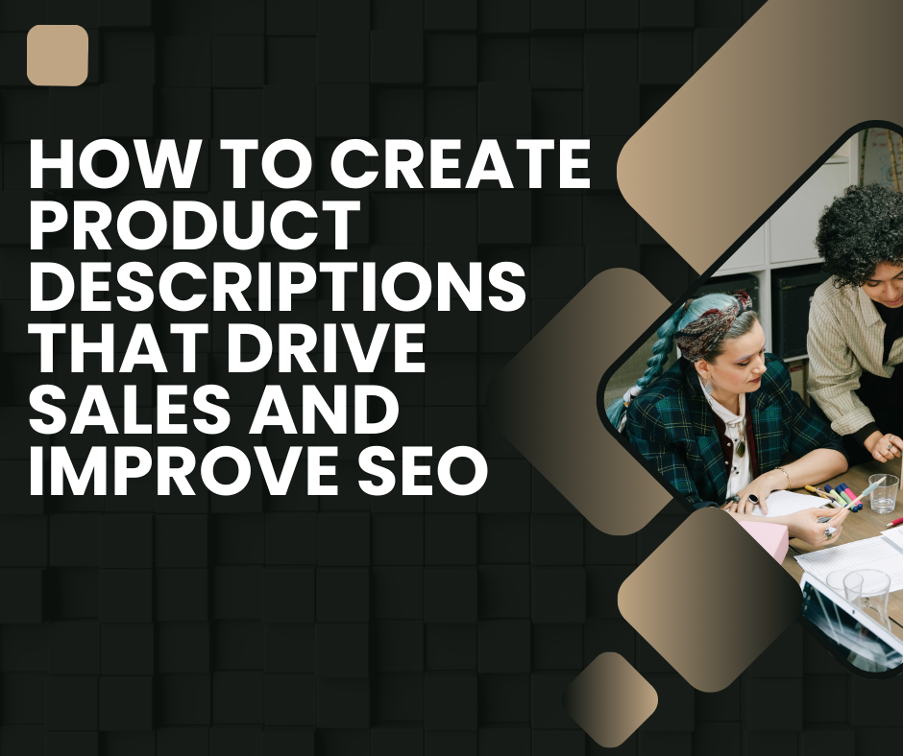How to create product descriptions that drive sales and improve SEO

Compelling product descriptions serve as silent salespeople that work tirelessly to convert visitors into customers. Yet many online retailers underestimate their power, treating them as mere afterthoughts rather than vital conversion tools. Well-crafted product descriptions not only persuade customers to purchase but also significantly impact your search engine rankings.
If you find yourself struggling to create descriptions that perform well on both fronts, professional eCommerce SEO services can provide the expertise you need. Many successful online retailers contact them to enhance their product listings and ensure they’re optimized for both human readers and search engine algorithms.
Why Product Descriptions Matter for Sales and SEO
Product descriptions fulfill two critical functions simultaneously. We mean the following:
- Conversion tool: They convince potential customers that your product meets their needs and is worth purchasing.
- SEO asset: These help search engines understand what you’re selling to make your products discoverable to relevant searchers.
When done right, product descriptions build trust, answer customer questions before they arise, and create emotional connections with your brand. However, writing captions that succeed at both sales and SEO requires specialized knowledge that many business owners lack, which is why expert ecommerce SEO services exist to fill this gap.
Key Elements of Effective Product Descriptions
1. Know Your Audience Intimately
Before writing a single word, you must understand who you’re writing for. Develop detailed buyer personas that capture:
- Demographics (age, gender, income level)
- Pain points and challenges
- Shopping preferences and behaviors
- Product knowledge level
- Language style that resonates with them.
This information allows you to address customers’ specific needs and concerns while using vocabulary and tone that feels relevant to them. When you speak directly to your audience’s unique situation, they’re far more likely to feel understood and develop the trust necessary to make a purchase.
2. Focus on Benefits, Not Just Features
Features tell; benefits sell. While technical specifications matter, customers ultimately care about how a product improves their lives. Consider this difference:
- Feature-focused: “This blender has a 1,000-watt motor and stainless steel blades.”
- Benefit-focused: “Blend even the toughest ingredients in seconds with our powerful 1,000-watt motor, while the professional-grade stainless steel blades ensure silky-smooth results every time.”
The second version connects features directly to outcomes that matter to customers.
3. Use Sensory Language
Online shoppers can’t physically interact with your products. Compensate for this limitation by using vivid language that appeals to the senses:
- Visual: “Vibrant crimson color that catches the eye”
- Tactile: “Butter-soft leather that molds to your hand”
- Auditory: “Whisper-quiet operation won’t disturb your household”
- Olfactory: “Subtle vanilla notes with hints of amber”
4. Craft Scannable Content
Online shoppers rarely read every word — they scan. Make your descriptions easy to digest by using:
- Bulleted lists for key features and benefits
- Short paragraphs (2-3 sentences maximum)
- Meaningful subheadings that highlight key selling points
- Bold text for crucial information
- Plenty of white space.
This structure allows busy shoppers to quickly find the information they need. Remember that most online shoppers make purchase decisions within seconds, so organizing your content strategically can dramatically improve conversion rates.
5. Incorporate Strategic Keywords
For SEO effectiveness, your product descriptions need relevant keywords. Follow these best practices:
- Research primary and secondary keywords for each product
- Include the main keyword in the product title and early in the description
- Add semantic keywords (related terms) throughout the text
- Use keywords in image alt tags and URLs
- Maintain natural readability — never stuff keywords.
6. Tell a Compelling Story
Stories create emotional connections and memorable experiences. Consider these storytelling approaches:
- Origin story: How or why the product was created
- Usage scenario: How a typical customer might use the product
- Problem-solution narrative: The issue your product solves
- Brand heritage: Your company’s experience or expertise.
For example, instead of just describing a coffee maker’s features, tell the story of how it was designed by barista champions to recreate café-quality coffee at home.
7. Address Objections Preemptively
Every potential purchase faces objections. Effective product descriptions anticipate and address these concerns:
- Price concerns: Emphasize value, longevity, or cost-per-use
- Quality concerns: Mention materials, craftsmanship, or warranties
- Comparison concerns: Subtly highlight advantages over alternatives
- Usage concerns: Explain ease of use or versatility.
8. Create a Sense of Urgency
Encourage immediate action by incorporating urgency and scarcity where appropriate. Consider the following:
- Limited time offers: “Special pricing ends Friday”
- Low stock warnings: “Only 5 left in stock”
- Seasonal relevance: “Perfect for the upcoming winter season”
- Anticipated price increases: “Prices will increase next month.”
How to Optimize Product Descriptions for Search Engines
While compelling content drives conversions, proper optimization ensures your products get found in the first place. You should try to do the following:
1. Conduct a Thorough Keyword Research
Use tools like Ahrefs, SEMrush, or Google’s Keyword Planner to identify:
- High-volume product-specific terms
- Long-tail queries with purchase intent
- Question-based searches related to your products
- Competitor ranking keywords.
These insights form the foundation of your SEO strategy. Revisit your keyword research quarterly to identify emerging trends and adjust your product descriptions accordingly to maintain a competitive advantage.
2. Structure Content with Schema Markup
Schema markup helps search engines understand your product information, potentially improving click-through rates with rich snippets. Include markup for:
- Product type
- Price
- Availability
- Reviews and ratings
- Brand
- SKU or model number.
3. Optimize for Mobile Search
With mobile shopping continuing to grow, ensure your product descriptions are mobile-friendly. Consider the following:
- Front-load important information
- Use shorter sentences and paragraphs
- Ensure text size is readable without zooming
- Test descriptions on multiple devices.
Mobile optimization impacts both user experience and search rankings. With Google’s mobile-first indexing now standard, failing to optimize your product descriptions for mobile devices can significantly hurt your visibility, regardless of how well-written your content might be.
4. Refresh Content Regularly
Search engines favor fresh content. Schedule regular reviews of your product descriptions to:
- Update outdated information
- Add new keywords as search trends evolve
- Incorporate customer feedback and questions
- Expand content based on analytics insights.
Measurement of the Impact of Your Product Descriptions

Track these metrics to assess the effectiveness of your product descriptions:
- Conversion rate by product
- Time spent on product pages
- Bounce rate
- Search engine ranking positions
- Customer questions after purchase
Bottom Line
Creating product descriptions that drive both sales and SEO performance is a delicate balance of art and science. By focusing on customer benefits, incorporating sensory details, and strategically using keywords, you can craft descriptions that not only rank well but also compel customers to buy.
Remember that exceptional product descriptions are investments that continue paying dividends through improved conversion rates and search visibility. If you lack the time or expertise to create them yourself, partnering with specialists in product content can deliver substantial returns on your eCommerce success.
Miss Clipping Out Stories to Save for Later?
Click the Purchase Story button below to order a print of this story. We will print it for you on matte photo paper to keep forever.

